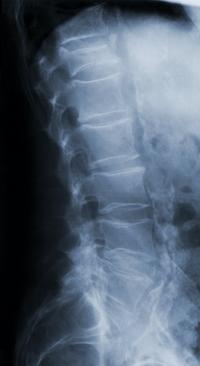
Osteoporosis
In Sweden, one in two women and one in four men suffer a fracture due to osteoporosis at some point in their lives. Why is this? Researchers at the Sahlgrenska Osteoporosis Centre, part of the Institute of Medicine, are conducting studies to explore the causes of osteoporosis and how to improve prediction, prevention and treatment of this condition.
Osteoporosis
Osteoporosis (bone brittleness) can affect children and adolescents as well as adults, but the risk of developing the condition rises steeply with advancing age. In Scandinavia, the risk of incurring osteoporotic fractures is the highest worldwide, for reasons that are still unclear.
In osteoporosis, the bone microstructure becomes markedly less dense, resulting in weakening of the skeleton. Fracture, even as a result of low-energy impact, is thus a major risk for people with the condition. As such, it causes no symptoms, but the associated fractures can have severe repercussions, such as reducing quality of life, impairing physical function and a raising the risk of morbidity and death. Among people who suffer a hip fracture, one in four dies within a year.
Apart from the victims’ suffering, osteoporotic fractures impose heavy costs and an immense burden on health care services. Of all inpatients in Swedish hospitals, only stroke victims need more days’ care than patients with osteoporotic fractures.
Our research areas
At the Institute of Medicine, researchers at the Sahlgrenska Osteoporosis Centre are engaged in studies intended to expand knowledge of what causes the condition and develop more reliable and effective treatments. We are also seeking to identify new risk markers that can indicate whether individuals are at high risk for bone fractures. It is the patients at highest risk who benefit most from osteoporosis medication.
Sahlgrenska Osteoporosis Centre
The Sahlgrenska Osteoporosis Centre comprises two units: the Centre for Bone and Arthritis Research (CBAR), a translational unit headed by Professor Claes Ohlsson, and the patient-centred Osteoporosis Clinic where Professor Mattias Lorentzon is Chief Physician.
Our researchers’ work
- Identifying genetic and environmental factors that can explain why so many people in Sweden suffer osteoporotic fractures.
- Identifying new drug targets for more efficacious pharmaceutical treatments, without side effects, to prevent fractures.
- Developing oestrogen therapy that involves no side effects for the patients.
- Understanding how the gut flora affects the skeleton and how probiotics can be used to prevent bone loss and fractures.
- Developing knowledge of how to prevent fractures and bone-related complications in children with kidney failure, diabetes and anorexia.
- Improving clinically accessible instruments for assessing fracture risk.
- Identifying specific routines and measures in health care that result in fewer fractures.
Important findings:
- Mapping of how hormones and genes affect bone mass and fracture risk. These studies have yielded ground-breaking knowledge of what causes osteoporosis.
- Charting the effects of inflammatory diseases on bone mass.
- Showing — another first for our researchers — that intestinal bacteria affect the skeleton, and that probiotics (dietary supplements with health-promoting bacteria) can reduce bone loss in women.
- Finding out that older patients receiving drug treatment for osteoporosis are protected against hip fractures after cortisone therapy is commenced.
OSTEOPOROSIS
The term “osteoporosis” is derived from the Greek words osteon (bone) and poros (pore). In everyday parlance, the word “porous” describes a material with numerous small holes that water and air can pass through. In osteoporosis, the microstructure of bones degenerates and bone-mineral density declines, making the bone weaker and more fragile. Even a low impact, such as from falling on the floor, then entails an elevated fracture risk.

Close connection between research and education
There is close cooperation between the Institute’s research and our education and training, in which many of our researchers too are involved. They supervise doctoral students and teach on our regular programmes, freestanding courses and vocational care programmes within Sahlgrenska Academy.


